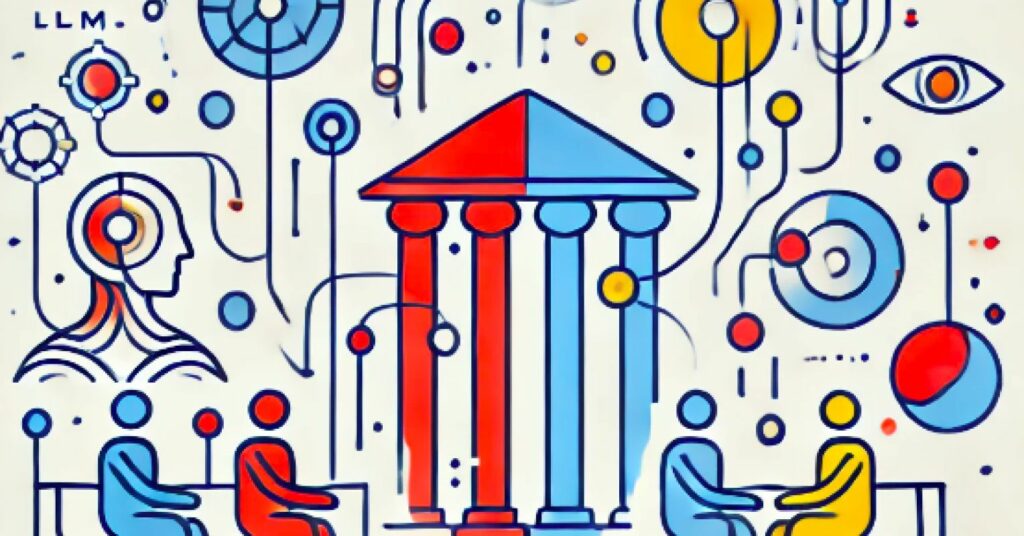Source: Art: DALL-E/OpenAI
Human collaboration has long been an engine of innovation, driving progress through shared ideas and collective effort. However, it’s often constrained by its most effective form—small groups, where intimate exchange and clear communication thrive. As groups grow, so do inefficiencies that limit how we work together. Yet, as we step into an era where large language models (LLMs) enter the cognitive dialogue, these limitations may no longer define the boundaries of collaborative potential.
Specifically, research shows that groups of five to seven members perform best, while larger teams often experience diminished productivity due to communication breakdowns and cognitive overload. This limitation holds true even in online communities. However, recent studies indicate that LLM clusters—groups of large language models—could redefine the nature of collaboration, offering the ability to scale efficiently without the drawbacks humans face.
A recent study on LLM group dynamics sheds light on how these models can engage in meaningful group dialogues without facing the same constraints as human groups. Unlike humans, LLMs can scale indefinitely, forming clusters that allow for the exchange of knowledge and ideas at an unprecedented level. Each model adds value to the conversation, cross-validating outputs and generating nuanced solutions, without the bottlenecks of emotional intelligence or social coordination.
LLM as a New Collaborative Powerhouse
This creates an interesting shift in how we approach collaboration. LLM clusters, composed of models, some specialized in different fields, can work together seamlessly to tackle complex problems. Whether it’s addressing global challenges like climate change or navigating intricate legal frameworks, LLM clusters have the potential to drive decision-making beyond human limits.
Specifically, the study suggests that while human productivity peaks in groups of five to seven members, LLMs show the ability to reach consensus even in groups exceeding this size. Beyond a critical threshold for humans, LLMs continue to perform well, with no significant drop in decision-making quality, potentially allowing LLM clusters to operate at scales that would overwhelm human teams. This offers exciting potential for scalable collaboration.
The Emergence of the Techno-Agora
A new form of collaborative thinking is emerging—the “techno-agora.” In this space, large-scale dialogues between LLMs can take place, fostering an environment where ideas flow freely and consensus can be reached without cognitive overload. The techno-agora doesn’t face the same social, emotional, or logistical hurdles that limit human assemblies, making it a powerful tool for industries ranging from scientific research to corporate strategy.
The recent study reinforces this notion by showing that LLMs, when engaged in group dialogue, don’t hit the same critical thresholds that humans do. Instead, they offer a scalable, efficient form of collaboration that could revolutionize the way we think about teamwork, problem-solving, and innovation. In some ways, it redefines the idea of the human “think tank” into a broader, technologically-based construct.
Potential Downsides of LLM Clusters
While LLM clusters present vast potential, they also introduce risks. Job displacement and economic disruption could occur as AI increasingly handles complex tasks, leading to shifts in industries and widening inequality. Over-reliance on AI might reduce critical thinking, while bias in AI models could lead to unfair outcomes in sensitive areas. Privacy and data security concerns will grow as LLM clusters require massive datasets. Additionally, issues of accountability, transparency, and the environmental impact of large-scale deployments pose ethical and societal challenges. Managing these risks will be crucial as we integrate LLM clusters into our future.
A Symbiotic Future
These LLM clusters have the potential to bring unparalleled computational power and scale, but this doesn’t mean humans are sidelined. Instead, the future may see humans and LLMs working together symbiotically. Humans provide creativity, ethical judgment, and emotional intelligence, while LLM clusters offer the ability to process vast amounts of information and collaborate at scales that would overwhelm human teams. In fact, the most powerful dialogues may soon take place not between humans, but between LLMs themselves, driving innovation forward.
As we chat our way into the future, LLM clusters may not only reshape collaboration but also redefine core aspects of human existence—from cognitive function to creativity and industry. Cognitive tasks traditionally limited by human processing capacity could now expand, as LLMs enhance our ability to engage in deeper analysis and rapid problem-solving. Creativity, often thought of as uniquely human, may evolve in partnership with LLM clusters, offering new ways to generate and refine ideas. Industries across the board could see an explosion of innovation as LLMs scale to address challenges that demand complex, multi-dimensional solutions.
The fusion of human intuition with LLM-powered efficiency signals the dawn of the Cognitive Age. This age of innovation might allow us to address the world’s most pressing problems with unprecedented clarity and speed. The challenge now is not merely adapting to LLM clusters but strategically deciding how to harness this transformative power to reshape industries, creativity, and even the future of human cognition itself.
The techno-agora is here—are we ready to step inside and embrace the possibilities?
Source link : https://www.psychologytoday.com/za/blog/the-digital-self/202410/the-techno-agora-how-llms-redefine-group-collaboration
Author :
Publish date : 2024-10-13 15:06:39
Copyright for syndicated content belongs to the linked Source.
